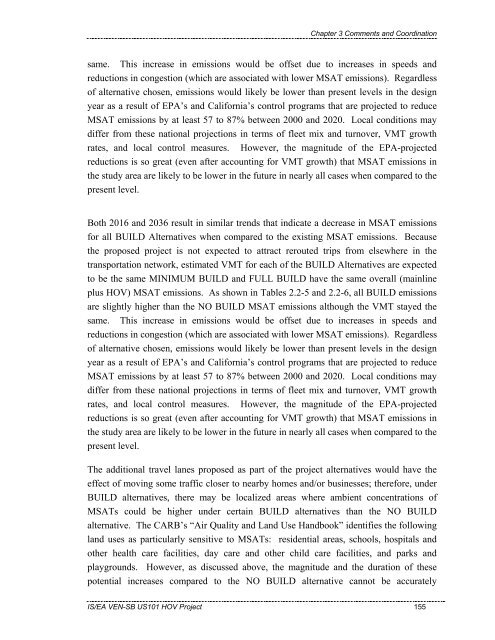Chapter 1 - Caltrans - State of California
Chapter 1 - Caltrans - State of California
Chapter 1 - Caltrans - State of California
Create successful ePaper yourself
Turn your PDF publications into a flip-book with our unique Google optimized e-Paper software.
<strong>Chapter</strong> 3 Comments and Coordination<br />
same. This increase in emissions would be <strong>of</strong>fset due to increases in speeds and<br />
reductions in congestion (which are associated with lower MSAT emissions). Regardless<br />
<strong>of</strong> alternative chosen, emissions would likely be lower than present levels in the design<br />
year as a result <strong>of</strong> EPA’s and <strong>California</strong>’s control programs that are projected to reduce<br />
MSAT emissions by at least 57 to 87% between 2000 and 2020. Local conditions may<br />
differ from these national projections in terms <strong>of</strong> fleet mix and turnover, VMT growth<br />
rates, and local control measures. However, the magnitude <strong>of</strong> the EPA-projected<br />
reductions is so great (even after accounting for VMT growth) that MSAT emissions in<br />
the study area are likely to be lower in the future in nearly all cases when compared to the<br />
present level.<br />
Both 2016 and 2036 result in similar trends that indicate a decrease in MSAT emissions<br />
for all BUILD Alternatives when compared to the existing MSAT emissions. Because<br />
the proposed project is not expected to attract rerouted trips from elsewhere in the<br />
transportation network, estimated VMT for each <strong>of</strong> the BUILD Alternatives are expected<br />
to be the same MINIMUM BUILD and FULL BUILD have the same overall (mainline<br />
plus HOV) MSAT emissions. As shown in Tables 2.2-5 and 2.2-6, all BUILD emissions<br />
are slightly higher than the NO BUILD MSAT emissions although the VMT stayed the<br />
same. This increase in emissions would be <strong>of</strong>fset due to increases in speeds and<br />
reductions in congestion (which are associated with lower MSAT emissions). Regardless<br />
<strong>of</strong> alternative chosen, emissions would likely be lower than present levels in the design<br />
year as a result <strong>of</strong> EPA’s and <strong>California</strong>’s control programs that are projected to reduce<br />
MSAT emissions by at least 57 to 87% between 2000 and 2020. Local conditions may<br />
differ from these national projections in terms <strong>of</strong> fleet mix and turnover, VMT growth<br />
rates, and local control measures. However, the magnitude <strong>of</strong> the EPA-projected<br />
reductions is so great (even after accounting for VMT growth) that MSAT emissions in<br />
the study area are likely to be lower in the future in nearly all cases when compared to the<br />
present level.<br />
The additional travel lanes proposed as part <strong>of</strong> the project alternatives would have the<br />
effect <strong>of</strong> moving some traffic closer to nearby homes and/or businesses; therefore, under<br />
BUILD alternatives, there may be localized areas where ambient concentrations <strong>of</strong><br />
MSATs could be higher under certain BUILD alternatives than the NO BUILD<br />
alternative. The CARB’s “Air Quality and Land Use Handbook” identifies the following<br />
land uses as particularly sensitive to MSATs: residential areas, schools, hospitals and<br />
other health care facilities, day care and other child care facilities, and parks and<br />
playgrounds. However, as discussed above, the magnitude and the duration <strong>of</strong> these<br />
potential increases compared to the NO BUILD alternative cannot be accurately<br />
IS/EA VEN-SB US101 HOV Project 155

















